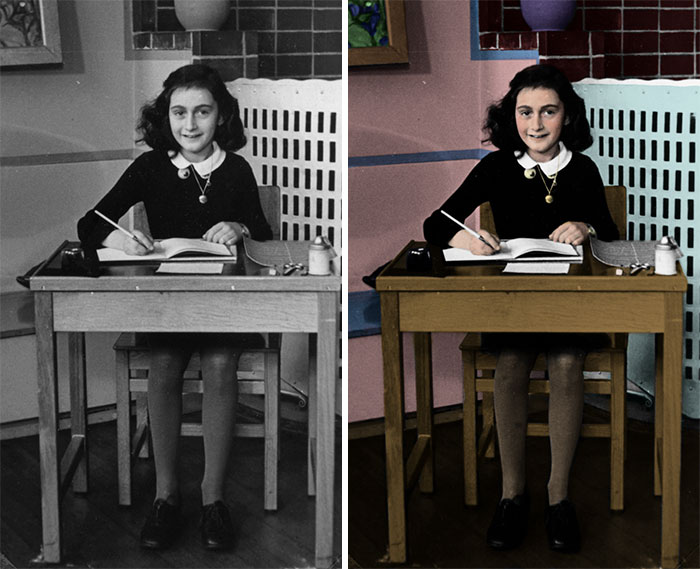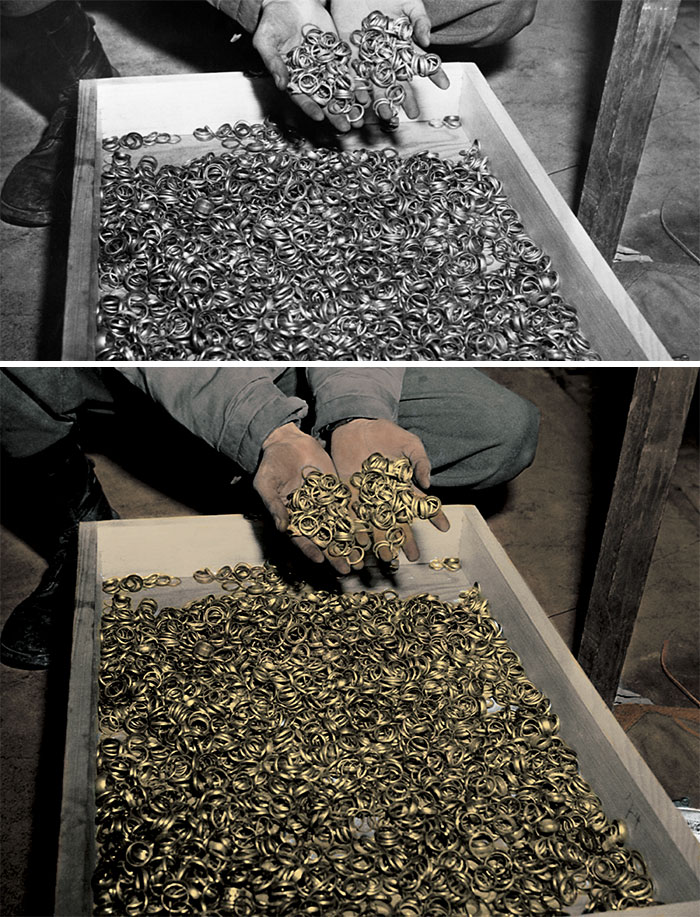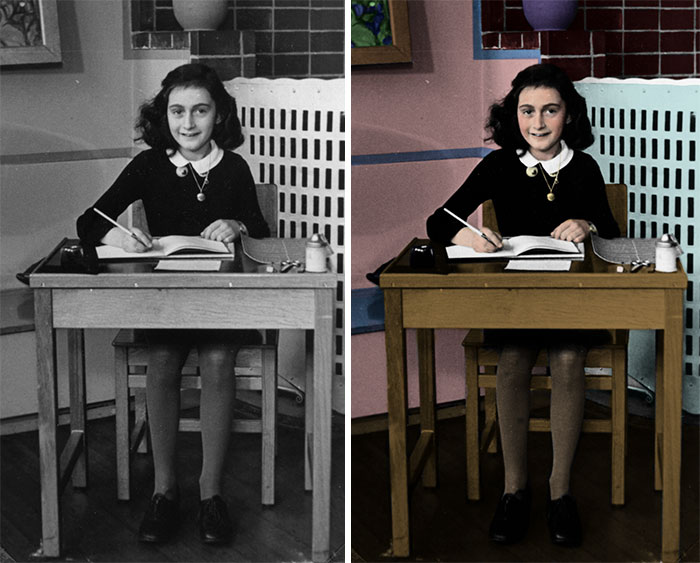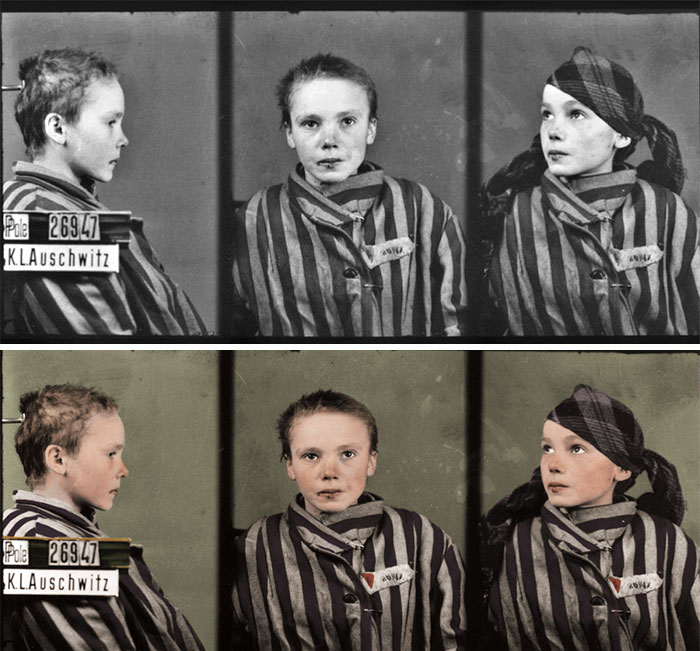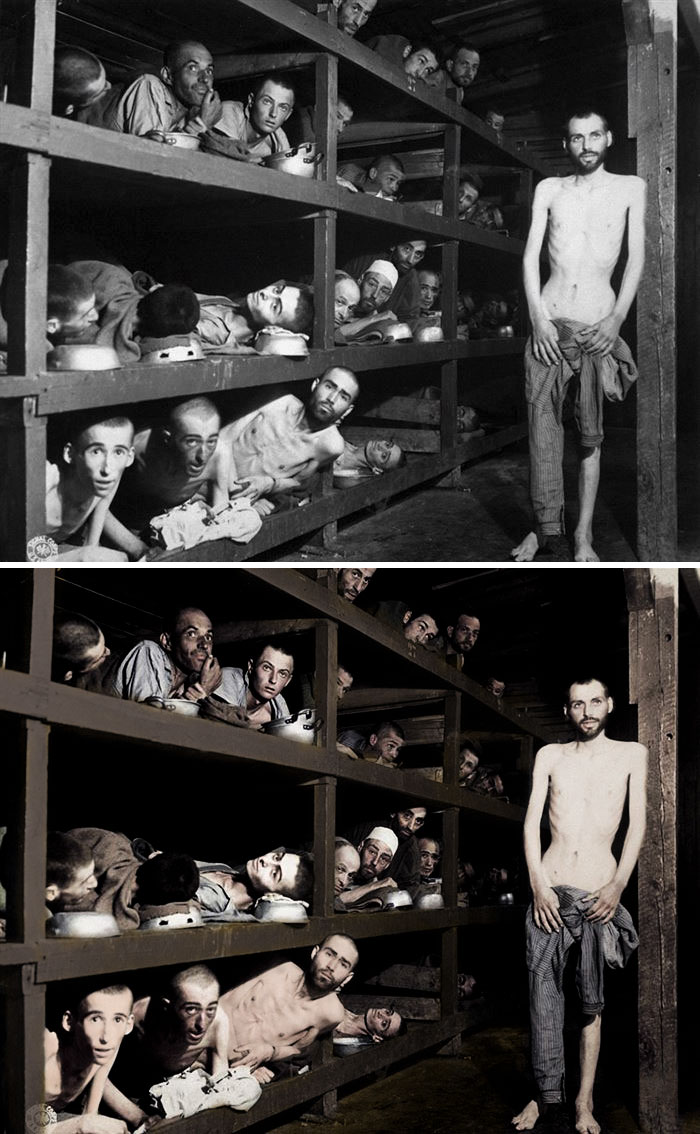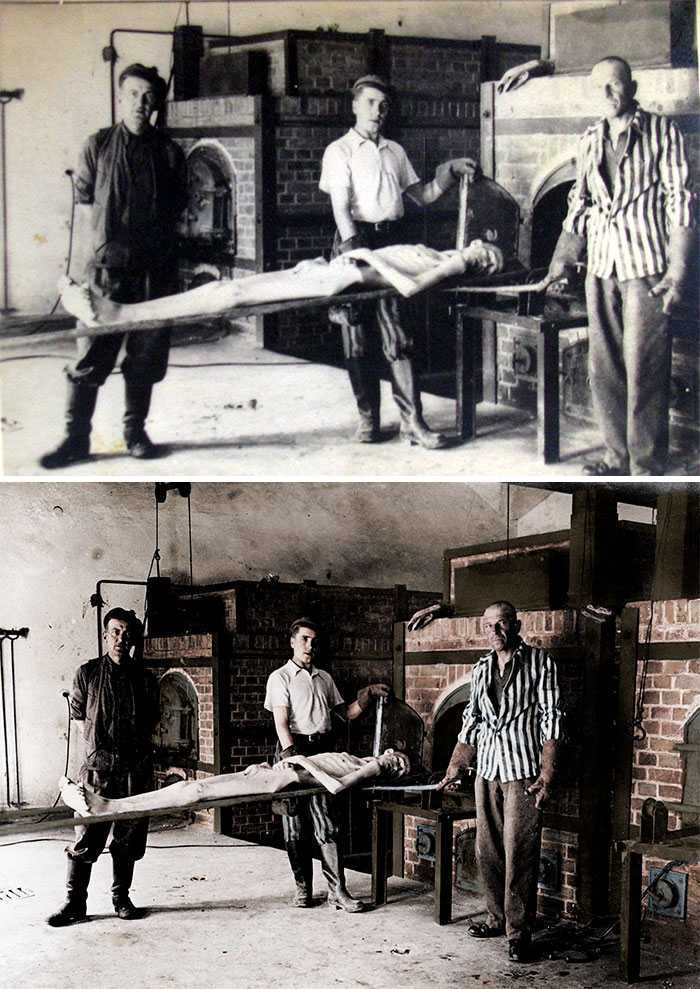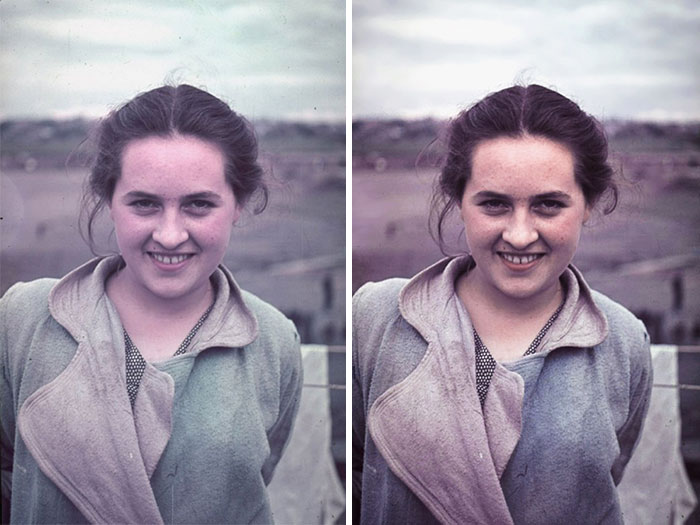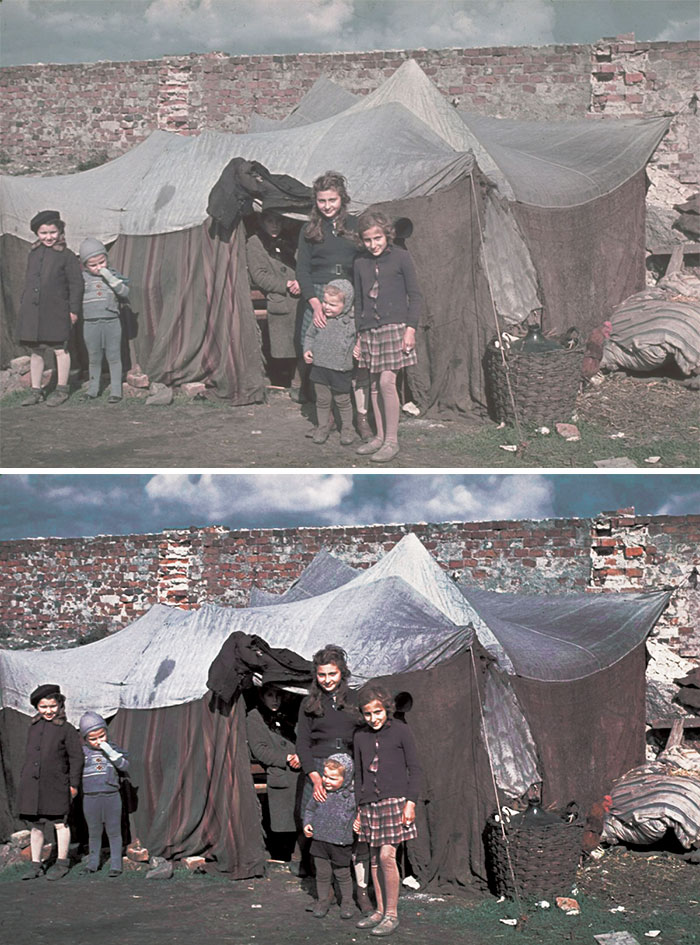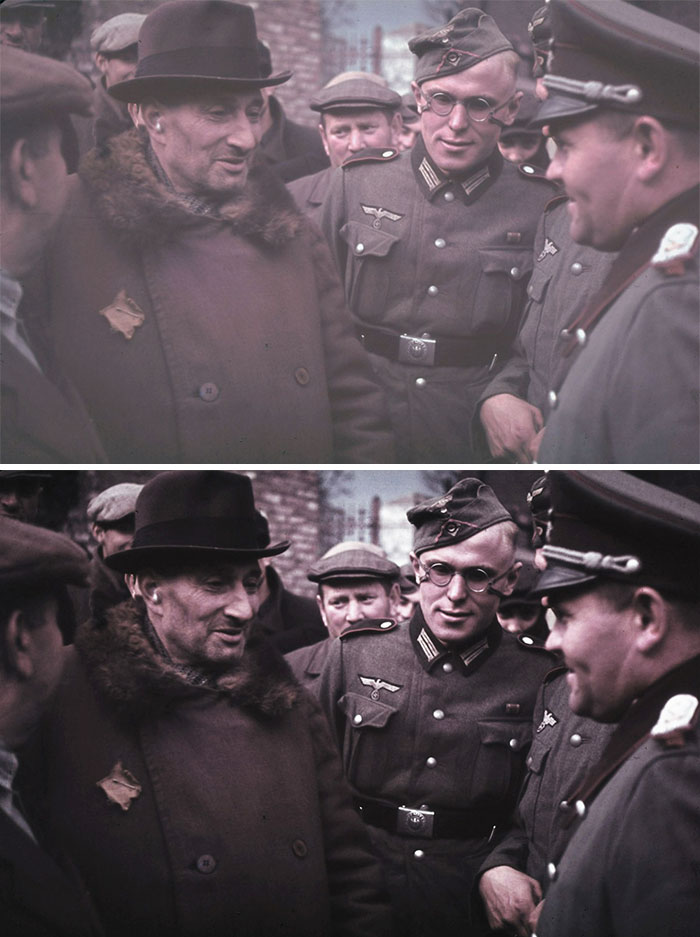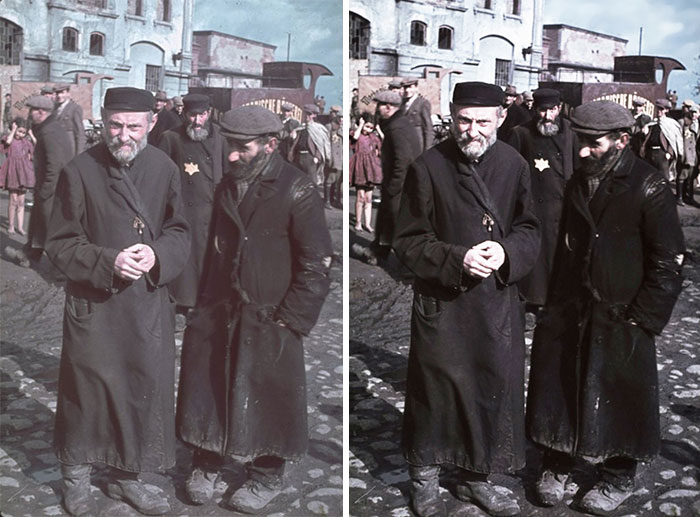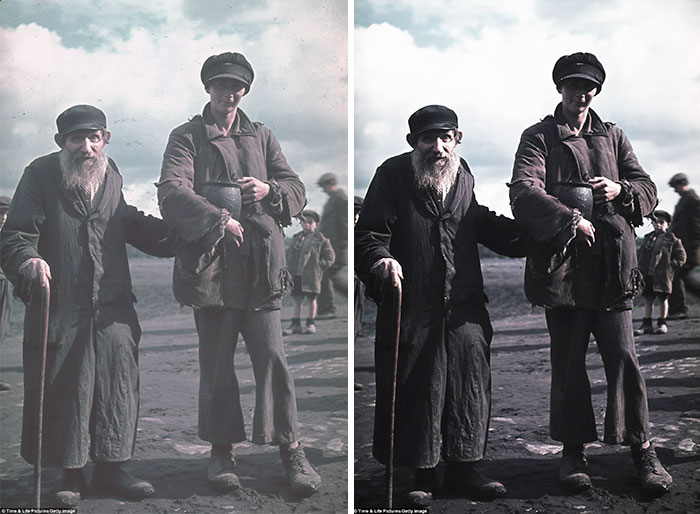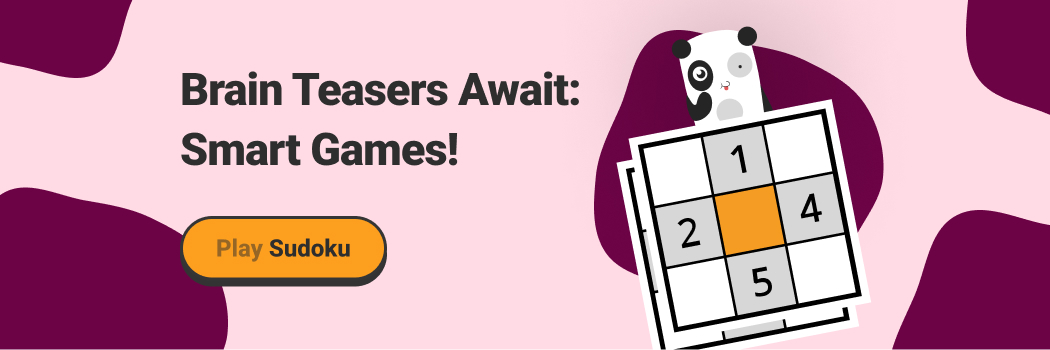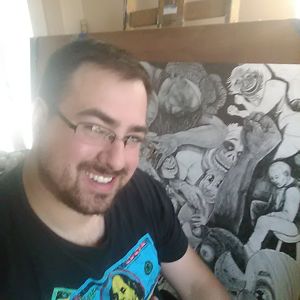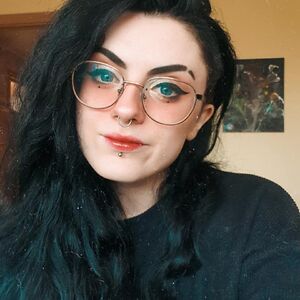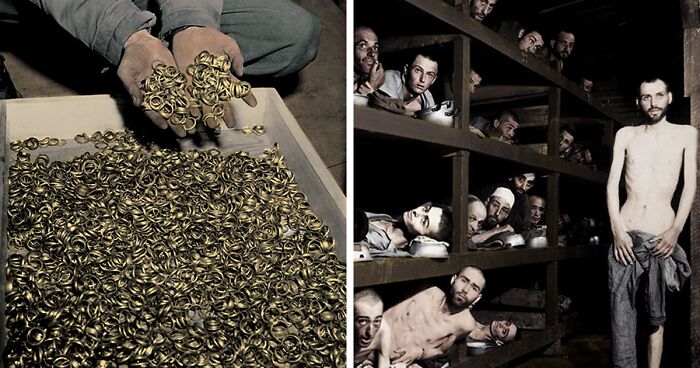
143Kviews
I Noticed That Some People Don’t Know Much About The Holocaust, So I Colorized These Photos (10 Pics)
I was recently shocked to read these words in The New York Times: "For seven decades, 'never forget' has been a rallying cry of the Holocaust remembrance movement."
But a survey released Thursday, on Holocaust Remembrance Day, found that many adults lack basic knowledge of what happened; and this lack of knowledge is more pronounced among millennials, whom the survey defined as people ages 18 to 34.
Thirty-one percent of Americans and 41 percent of millennials believe that two million or fewer Jews were killed in the Holocaust; the actual number is around six million. Forty-one percent of Americans and 66 percent of millennials cannot say what Auschwitz was. And 52 percent of Americans wrongly think Hitler came to power through force.
I first started working on this historical photo project several years ago, using contemporary reference images to colorize and restore pictures from the Holocaust. I did publish the colored pictures on my Facebook and my blog, but now I realize that that wasn't nearly enough so I worked on the picture restoration a bit more, and I'm publishing them again here. It seems to me that black and white pictures colorized will help people to better empathize with the victims of the Holocaust and I hope that any artist that is interested in working with me to make more color pictures or even to improve the ones that I've colorized so far would please contact me. I am also interested in being contacted by anyone who could help me with this history picture project in general. This project is not for profit, but feel free to follow me on my Facebook, Instagram, Patreon or YouTube or check out my webpage.
More info: joachimwest.com | Instagram | patreon.com | youtube.com
This post may include affiliate links.
Wedding Bands Found During The Liberation Of Buchenwald Concentration Camp
I was surfing the internet and I came across a webpage that featured photographs of famous people that had been colorized. These were photographs that I had seen a million times, the face of Abraham Lincoln, a photograph of Amelia Earhart standing next to her plane, etc. but when I saw them colorized it was as if I was seeing them for the first time. It was as if they had stepped out of a foggy world of memories and into reality.
I’m a fine artist who makes work about society and I come from a Jewish/Spanish family, so I grew up hearing stories of the hardships that my family went through because of fascism and hate. Because it has touched my life directly, it’s easy for me to sympathize with the victims of the Holocaust and to realize that we have lost so much because of it but it’s obvious to me that not everyone feels the same way.
I thought to myself, “I should make a body of colorized photographs of the holocaust that Holocaust museums could exhibit and that people who educate about the Holocaust could use to help their students to sympathize with the victims. Someone must have done this already, though…” but I went about searching the internet to see if I could find it. I couldn’t find it. It didn’t exist.
I decided to go ahead and make some colorized images of the Holocaust so that I could propose the idea of exhibitions to Holocaust museums who I thought could get these resources into the hands of Holocaust educators. I have some basic knowledge of Photoshop and plenty of experience as a painter, but I had no idea how to colorize a photograph. I taught myself how to do it and I scoured the internet for photographs of the settings and clothing to make them as accurate to history as possible.
I then wrote emails to various Holocaust educators with my images attached. I received no interest. It honestly depressed me. I gave up on the project.
I moved to Spain, to the village that my mother grew up in. I was fascinated by the graffiti that littered the town and began to make artwork about that instead. There was a sort of political war between neo-Nazis and young communists that largely seemed focused on issues of immigration that were playing out and evolving on the walls of the town. While it isn’t hard to find the same sort of hatred that inspired the Holocaust on the internet, swastikas littered the town where I lived. Why don’t these young people learn from the past? I was thinking about the issue every day.
I read an article in the New York Times on Holocaust Remembrance Day that published statistics about the shocking amount of ignorance about the Holocaust among millennials and it reminded me of the colorized photographs that I had made. Yes, they had been rejected by the Holocaust museums, but it wasn’t a bad idea, maybe they just needed a different venue. I thought of Bored Panda. I’ve posted my work here before and nothing clicked but I decided to give it a try anyway.
The results were staggering. Absolutely incredible. So many people have seen these colorized photographs and while I am still very scared for humanity, it gives me hope.It is very important that the world never forgets the Holocaust because it is such a poignant lesson of the horrors and loss that come from ignorance and hatred.
Colorized Photograph Of Anne Frank
Honestly, I love learning about the Holocaust. Ot is just an interesting topic for me, as I come from German decent. I don't think anyone should forget about it, and I think the people who say it didn't happen need to hit reality.
I learned about colorizing photographs for the express purpose of doing this project and I’m sure that there are many people who are better at it than I am but the way that I do it is to make a black and white layer on the bottom in Photoshop and a black and white layer on top and I paint in the color in the middle, a lot like one would paint a painting. It’s like a color sandwich.
Historical accuracy is extremely important to me because there are people who believe that the Holocaust never happened. There is always the threat that someone might say “this is fake” but I think that these colorized photographs are even more true to reality than the black and white photos that were taken at the scene because we don’t see the world in black and white. We see the world in color.
I was very careful to gather and look at as many source images as I could and because the concentration camps still exist and because many of the uniforms and patches still exist, I could sample the colors directly from contemporary reference photographs.
Colorized Photo Of A Catholic Girl. Czesława Kwoka, 1942-43
I read the story of this girl, I can't remember her name but she was very young, around 12 years old I think. The dark colour marks on her lips are blood; she was beaten by a female officer before the photo was taken because she was crying. It's so very heartbreaking.
I’ve always loved art and I’ve always been drawn to it. My family saw that I had a talent and love for it from an early age and always supported me in it. Maybe it’s because I’m the kind of person who is deeply affected emotionally by the things that are around me? Colors affect my mood, for example. If my environment is a mess, I feel a certain way. If a room is clean, I feel differently. I can be deeply moved by a painting or a sculpture.
I did various private classes as a child and many days I would come home after school and lock myself away and make sculptures or draw and paint. I then did an undergraduate degree in Fine Art at the University of Texas at Dallas and then moved to Spain to do a Master's Degree in Fine Art.
The only reason that I learned to colorize photographs was to do this project, but I have honestly used the same technique to colorize a lot of things since then in Photoshop for my own personal amusement.
Colorized Photograph From Auschwitz Concentration Camp
Learning about history informs our image of ourselves. It helps us to understand who we are and where we come from. It shows us that we are capable of great things and terrible things. It gives us courage and inspiration to do tremendous and difficult things and gives us lessons to avoid certain things. History should help us to build a roadmap in our minds of where we would like to go, not only as individuals but as societies. It teaches us that we are most successful when we have empathy for each other and work together to make the world a better place for all of us.
Colorized Photo From The Daschau Concentration Camp
I’m Jewish and the Holocaust has a personal significance. It’s not unusual for me to be randomly surfing the internet and find anti-Semitic comments about the Jews or to even hear or see reminders that people hate the Jews in my daily life. The same prejudices that existed then still exist today and I live with the fact that there are plenty of people who would be happy for me to be killed or to kill me simply because of my genetic makeup.
Yet the Holocaust isn’t only significant for me. The Nazis didn’t only kill Jews. They killed people with disabilities, people who were LGBTQ, and people who thought differently about the world. The Holocaust is also a tremendous example of the disasters and horrors that come about when those kinds of people are put into positions of power and the importance of empathy for other human beings. It was disastrous not only for the people who the Nazis persecuted but for all of Germany as Germany was left in shambles following the Second World War.
I’m very concerned that we haven’t learned the lessons of the Holocaust. Concentration camps still exist today. Genocide still happens. Anti-Semitism is still prevalent and violent and maniacal people are still being put into positions of power, people who hate other people simply because they are different. I’m afraid that authoritarianism is still extremely prevalent, and I worry for humanity, that people are quick to give up their personal freedom to corruptible and abusive people and slow to work together to take care of the people who need help and slow to fight against abusive people for the sake of their victims.
Poland, 1939-40
She has such a beautiful face. Seeing something like this makes it seem like not so long ago.
I didn’t do this project for money. I haven’t made a dime from it. I did it because I want people to be able to sympathize with the victims of the Holocaust because only when people care about those who are persecuted can we work to help them and thereby make the world a better place.
We need people to care for other people. People need to know that they should care for each other and why. It’s an issue of education and I see this project as an educational tool.
I am largely inspired by my fear of what is happening around us in the world and what can happen to us if we don’t fight against our baser instincts to kill each other over stupid things. I am also concerned about our inaction against tyranny when we don’t stand up to fight against truly terrible things that are happening in our world. Ignorance is an extremely dangerous thing and I want it to go away, whether it is in me or in the world.
Poland, 1939-40
I think that if you can attend a class and learn how to use programs that will let you colorize things like Photoshop, that’s really the best way to go about it. If you don’t have the money, you might consider asking the professor of the class if you can audit the class. If you are autodidactic, then there really is a ton of information on the internet about how to use these programs and lots of great videos that will walk you through the steps of learning to use a program that will allow you to colorize a photograph.
Poland, 1939-40
I have a girlfriend who I love very much and who is very supportive of my art. We started our relationship at an art show about six years ago during Halloween. She was dressed as a bunny and I was dressed like a stereotypical artist with a striped shirt and a beret. I was exhibiting my artwork and she had organized an artistic intervention to disrupt the event. We have been inseparable since then.
I have shown my artwork in many different countries and across the United States and have traveled between the United States and Spain many times throughout my life. I look forward to going again.
I’ve always made art and I’ve been hiding away from the world and making artwork since I was young. I often don’t show anyone the things that I make.
I strongly believe that art can change the world, sometimes it even changes it for the worse, but I very much want my art to be a force for good in the world. I don’t think that that necessarily means that art must talk about race or politics or religion or social issues at all. Sometimes just seeing something beautiful can make a person’s day better and that is one way to change the world for the better.
Poland, 1939-40
Bakery trucks bringing them bread in the ghetto. Language on the side is German, though Polish could be similar. I am so sad looking at this, their earnest faces filled with anger and worry, and the little girl in the background inexplicably happy about something.
I don’t think that I’m done with this project and answering these questions has been inspiring. I think that I’m going to go to my local Holocaust museum and see if I can talk to the directors face to face. Perhaps knowing that these colorized images that were rejected by many Holocaust museums have been seen by so many people will be proof that colorized images of the Holocaust can help people to remember, to sympathize, and to learn and understand, and never forget.
Poland, 1939-40
Those statistics shock me. What is even worse is that with time they are only going to get higher. I was at a Holocaust Memorial in Boston recently and was shocked at a teenager who kept saying, "What are all these names for?" The questions he kept throwing out were amazing but then I realized that at least (the very least) he was asking because the memorial was there. Never forget indeed. Lets hope there are enough people in the world who are not apathetic in the future to let it happen.
The schools are not teaching them these things. If they do, they gloss it over and move on to more pleasant topics. The teachers are more concerned about keeping the students "happy" than teaching them hard cold facts. When I was in school, our teacher drilled this into us, we read the history, we saw the photos, we saw the films. Yes, we were shocked by it, but we remember.
Load More Replies...And still, there are peple in my country, who compare jewish stars to vaccination (aka, that unvaccinated people are like jewish people - marked by society). Absolutely disgusting. But thanks for the photos, they are a reminder of those, who died (including a big part of my family from my mums side)
It's disgusting that anyone would dare to try & compare the current pandemic & the need for vaccinations to what happened in the Holocaust.
Load More Replies...the added colour somehow makes them more real, more relate-able, sadder, even more soul shatteringly shocking and they were always these things and more. I guess some people might be able to distance themselves from the events because of the aged black and white world it seems to have been (as apposed to the multi-colour world of today), but there's was an experience that should never be forgotten, always remembered and those lost held forever near. (hope that all makes sense)
Those statistics shock me. What is even worse is that with time they are only going to get higher. I was at a Holocaust Memorial in Boston recently and was shocked at a teenager who kept saying, "What are all these names for?" The questions he kept throwing out were amazing but then I realized that at least (the very least) he was asking because the memorial was there. Never forget indeed. Lets hope there are enough people in the world who are not apathetic in the future to let it happen.
The schools are not teaching them these things. If they do, they gloss it over and move on to more pleasant topics. The teachers are more concerned about keeping the students "happy" than teaching them hard cold facts. When I was in school, our teacher drilled this into us, we read the history, we saw the photos, we saw the films. Yes, we were shocked by it, but we remember.
Load More Replies...And still, there are peple in my country, who compare jewish stars to vaccination (aka, that unvaccinated people are like jewish people - marked by society). Absolutely disgusting. But thanks for the photos, they are a reminder of those, who died (including a big part of my family from my mums side)
It's disgusting that anyone would dare to try & compare the current pandemic & the need for vaccinations to what happened in the Holocaust.
Load More Replies...the added colour somehow makes them more real, more relate-able, sadder, even more soul shatteringly shocking and they were always these things and more. I guess some people might be able to distance themselves from the events because of the aged black and white world it seems to have been (as apposed to the multi-colour world of today), but there's was an experience that should never be forgotten, always remembered and those lost held forever near. (hope that all makes sense)

 Dark Mode
Dark Mode  No fees, cancel anytime
No fees, cancel anytime 




